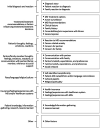Factors that influence treatment decisions: A qualitative study of racially and ethnically diverse patients with low- and very-low risk prostate cancer
- PMID: 36404625
- PMCID: PMC10028041
- DOI: 10.1002/cam4.5405
Factors that influence treatment decisions: A qualitative study of racially and ethnically diverse patients with low- and very-low risk prostate cancer
Abstract
Background: Factors that influence prostate cancer treatment decisions are complex, multifaceted, and personal, and may vary by race/ethnicity. Although research has been published to quantify factors involved in decision-making, these studies have been limited to primarily white, and to a lesser extent, Black patients, and quantitative studies are limited for discerning the cultural and contextual processes that shape decision-making.
Methods: We conducted 43 semi-structured interviews with a racially and ethnically diverse sample of patients diagnosed with low- and very-low risk prostate cancer who had undergone treatment for their prostate cancer. Interviews were transcribed, independently coded, and analyzed to identify themes salient for decision-making, with attention to sociocultural differences.
Results: We found racial and ethnic differences in three areas. First, we found differences in how socialized masculinity influenced patient's feelings about different treatment options. Second, we found that for some men, religion and spirituality alleviated anxiety associated with the active surveillance protocol. Finally, for racially and ethnically minoritized patients, we found descriptions of how historic and social experiences within the healthcare system influenced decision-making.
Conclusions: Our study adds to the current literature by expounding on racial and ethnic differences in the multidimensional, nuanced factors related to decision-making. Our findings suggest that factors associated with prostate cancer decision-making can manifest differently across racial and ethnic groups, and provide some guidance for future research.
Keywords: prostate cancer; psychosocial studies; quality of life; translational research.
© 2022 The Authors. Cancer Medicine published by John Wiley & Sons Ltd.
Figures
Similar articles
-
The physician's professional role in end-of-life decision-making: voices of racially and ethnically diverse physicians.Patient Educ Couns. 2010 Jul;80(1):3-9. doi: 10.1016/j.pec.2009.10.018. Epub 2009 Nov 30. Patient Educ Couns. 2010. PMID: 19948388 Free PMC article.
-
Palliative care experiences of adult cancer patients from ethnocultural groups: a qualitative systematic review protocol.JBI Database System Rev Implement Rep. 2015 Jan;13(1):99-111. doi: 10.11124/jbisrir-2015-1809. JBI Database System Rev Implement Rep. 2015. PMID: 26447011
-
Racial/ethnicity differences in endorsing influential factors for prostate cancer treatment choice: An analysis of data from the personal patient profile-prostate (P3P) I and II trials.Urol Oncol. 2020 Mar;38(3):78.e7-78.e13. doi: 10.1016/j.urolonc.2019.10.015. Epub 2019 Dec 27. Urol Oncol. 2020. PMID: 31883873
-
Current research findings on end-of-life decision making among racially or ethnically diverse groups.Gerontologist. 2005 Oct;45(5):634-41. doi: 10.1093/geront/45.5.634. Gerontologist. 2005. PMID: 16199398 Review.
-
The impact of ethnicity on decisions and decision making in prostate cancer: an integrative review.Ethn Health. 2025 Feb;30(2):316-336. doi: 10.1080/13557858.2024.2429416. Epub 2024 Nov 19. Ethn Health. 2025. PMID: 39560506 Review.
Cited by
-
Comparative analysis of treatment decision-making in patients with localized prostate and cervical cancer: what influences receiving surgery or radiotherapy?Support Care Cancer. 2024 May 29;32(6):391. doi: 10.1007/s00520-024-08589-x. Support Care Cancer. 2024. PMID: 38806815 Free PMC article.
-
Key Determinants Influencing Treatment Decision-Making for and Adherence to Active Surveillance for Prostate Cancer: A Systematic Review.J Pers Med. 2025 Jul 15;15(7):315. doi: 10.3390/jpm15070315. J Pers Med. 2025. PMID: 40710432 Free PMC article. Review.
-
Patient and physician perspectives on treatments for low-risk prostate cancer: a qualitative study.BMC Cancer. 2023 Dec 5;23(1):1191. doi: 10.1186/s12885-023-11679-4. BMC Cancer. 2023. PMID: 38053037 Free PMC article.
-
Patient perspectives on factors influencing active surveillance adherence for low-risk prostate cancer: A qualitative study.Cancer Med. 2024 Jan;13(1):e6847. doi: 10.1002/cam4.6847. Epub 2023 Dec 27. Cancer Med. 2024. PMID: 38151901 Free PMC article.
-
A Scoping Review of Stigma Related to Prostate Cancer in Black Men.J Racial Ethn Health Disparities. 2025 Aug;12(4):2521-2559. doi: 10.1007/s40615-024-02070-5. Epub 2024 Jul 9. J Racial Ethn Health Disparities. 2025. PMID: 38980523 Free PMC article.
References
-
- Carroll PH, Mohler JL. NCCN guidelines updates: prostate cancer and prostate cancer early detection. J Natl Compr Canc Netw. 2018;16(5 S):620‐623. - PubMed
-
- Sanda MG, Cadeddu JA, Kirkby E, et al. Clinically localized prostate cancer: AUA/ASTRO/SUO guideline. part II: recommended approaches and details of specific care options. J Urol. 2018;199(4):990‐997. - PubMed
-
- Heidenreich A, Aus G, Bolla M, et al. EAU guidelines on prostate cancer. Eur Urol. 2008;53(1):68‐80. - PubMed
-
- Albertsen PC. When is active surveillance the appropriate treatment for prostate cancer? Acta Oncol. 2011;50(sup1):120‐126. - PubMed


